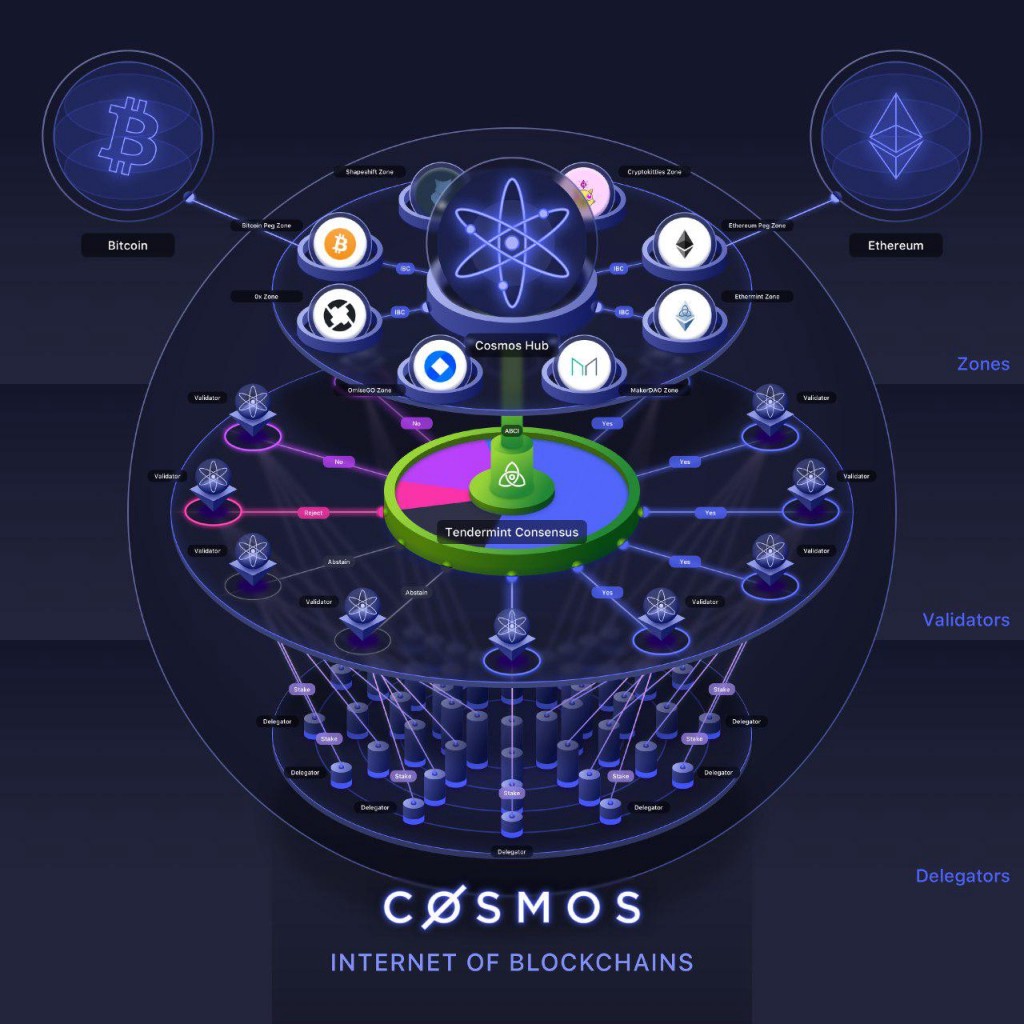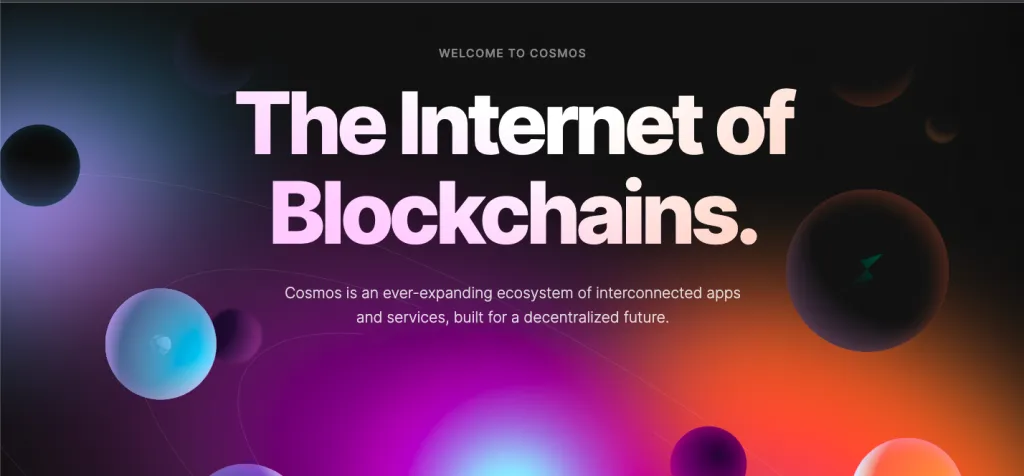Table of Contents
The Cosmos network is a one of a kind blockchain framework. Just like the Internet of things (IOT) where physical devices around the world are able to communicate with one another via the Internet, Cosmos allows unique blockchains to collectively exchange information under a shared network, which is why it’s termed as the “Internet of blockchains”.
The concept of an “Internet for blockchains”, while nascent, is extremely compelling because it highlights the limitations of isolated networks. The reality is that no single blockchain will serve as the sole underlying infrastructure for Web 3.0, and if the technology is to become the next generation financial system, data fluidity between unique blockchains will undoubtedly be crucial.
Cosmos facilitates data transfer between blockchains by focusing on interoperability and customisation via three main tools: Tendermint Byzantine Fault Tolerance (BFT) Engine, Cosmos Software Development Kit (SDK), and the Inter-Blockchain Communication (IBC) Protocol.
Cross-chain DeFi
The Cosmos Hub is the first blockchain to be launched on the Cosmos network. It acts as an intermediary; a facilitator of interoperability between independent blockchains within the Cosmos network known as “zones”.

Last year, Gravity DEX (decentralised exchange) was launched on Cosmos Hub, enabling cross-chain decentralised finance (DeFi) transactions in the Cosmos ecosystem. Gravity DEX allows swaps and pools of digital assets between any blockchain to occur within Cosmos, creating a powerful DeFi ecosystem where data and assets can be exchanged between multiple blockchains under a single network.
Developer-friendly
Continue to bear with the space jargon.
The Tendermint BFT Engine is an open source tool by software development company Tendermint (the main developer behind Cosmos) that allows developers to create and add to new zones without having to code them from scratch, which means that the process of adding blockchains to the Cosmos network is drastically simplified.
Each zone is powered by the Tendermint proof-of-stake byzantine fault tolerant (BFT) consensus algorithm, which allows the network to reach consensus even if some of the nodes (validators) fail or act maliciously. This creates a more secure ecosystem where the undesirable actions of individual nodes are unable to affect the integrity of the entire network.
The Tendermint Core – the proof-of-stake consensus mechanism that governs the network of transaction validators – coordinates ATOM, which ensures the security of the Cosmos Hub and can be delegated to one or more of the 125 validators on the Cosmos Hub blockchain to earn more ATOM.
A customisable ecosystem
The Cosmos SDK allows developers to build customisable blockchain applications.
Modules include:
- Ethermint, an EVM (Ethereum Virtual Machine) that makes it possible for developers to develop proof-of-stake blockchain applications that are compatible and interoperable with Ethereum. Developers can leverage Ethereum tools to deploy smart contracts while using Tendermint’s PoS functionality. The applications (e.g. Ethereum-based DeFi protocols) will be able to interact with the Cosmos ecosystem through the Inter-Blockchain Communication Protocol (IBC)
- Starport is an open source prototyping tool that allows developers to design application-specific, sovereign blockchains that can be connected to the Cosmos network. This means that blockchains built by Starport are layer-1 protocols that are not dependent on a another layer-1 protocol or a central chain (e.g. applications built on Ethereum or parachains dependent on Polkadot’s Relay Chain). All chains built with Starport are also IBC-enabled by default.
A number of prominent projects such as Binance DEX and Terra were built using Cosmos SDK.
Boosting interoperability
The ability for blockchains to interoperate will define the technology’s success and shape its trajectory towards mainstream adoption in the coming years. The lack thereof, however, will result in siloed ecosystems where data cannot be transferred between networks, much akin to a fragmented financial system where banks and clients are unable to communicate and/or exchange assets with one another.
Therefore, blockchains have to achieve interoperability to be able to function collectively as a unified system independent of centralised repositories. Cosmos’ IBC enables data to travel freely between zones, therefore allowing different blockchains each with their own unique applications and consensus mechanisms to exist, interoperate, and transact with one another under a single network – a crucial characteristic if blockchain technology is to be adopted as the foundation of Web 3.0.

The IBC currently hosts 38 distinct blockchains with a combined market capitalisation of more than US$60 billion, allowing users to easily exchange a wide variety of data and tokens. Prominent networks include Cronos (CRO) and Terra (LUNA, UST), and LikeCoin (LIKE). The IBC will also likely be connected to external ecosystems including Bitcoin, Ethereum, and Polkadot in the near future, with cross-chain protocols like the Nomic Bitcoin Bridge, Axelar and Datachain facilitating the transfer of data between Cosmos and those networks.
Nomic Bitcoin Bridge, for example, creates a new asset, nBTC, which is IBC compatible and redeemable for bitcoin, therefore allowing different types of protocols on Cosmos (e.g. Terra) to potentially use bitcoin in liquidity pairings or as a reserve asset.
Cosmically undervalued
Cosmos isn’t one of the many space-related gimmicks that only offers short-term gains. It’s a welcoming ecosystem that allows participants to interact with multiple networks, therefore solving one of blockchain technology’s biggest challenges– the inability for networks to share data with each other.
Blockchains and dApps (decentralised applications) can also be easily developed on Cosmos, making it an attractive network for both developers and investors. While Cosmos isn’t a metaverse-focused project, its facilitation of interoperability can also create opportunities for developers to build interoperable and realms, which is what many consider to be how the metaverse should function in the future.

At the time of publication, Cosmos (ATOM) is trading at US$ 31.41, recently topping US$7 billion in market capitalisation. Cosmos is cosmically undervalued, and as the importance of interoperability becomes more apparent, the Internet of blockchains might just offer investors galactic gains in the long-run.









